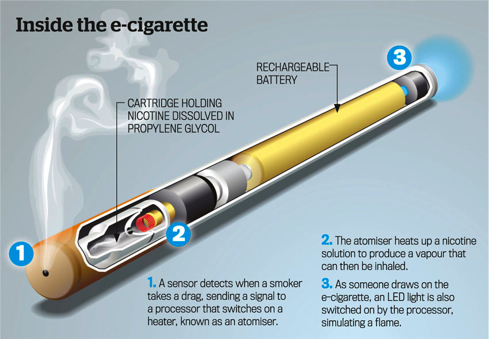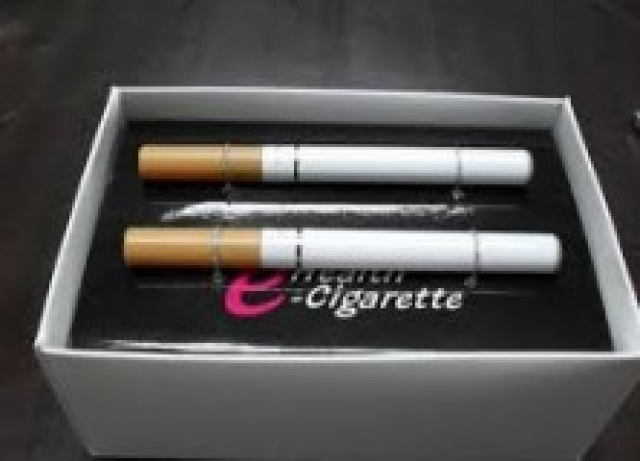 I haven’t had a cigarette in a month. That is, I haven’t had a real cigarette.
I haven’t had a cigarette in a month. That is, I haven’t had a real cigarette.
Electronic cigarettes, better known by their shortened name, e-cigarettes, uses a technology that turns synthetic nicotine-infused propylene glycol into a vapor that is inhaled. e-cigarettes smoke almost like the real thing, only without the smelly odor, ashes, nicotine stains, tar, burned clothing, and the numerous other detriments found when lighting up real cigarettes.
They are gaining such popularity that the United States is following Europe in a desire to regulate their use and to control their sale.
While e-cigarettes are still a fraction of the $80 billion-a-year market for smoking products in the United States, the growing popularity of vaping, as the practice is known, has touched off a clash in the U.S. between retailers and regulators. A clash that was brought over from Europe.
The British government announced it would begin treating e-cigarettes as medicines, “so that people using these products have the confidence they are safe, are of the right quality and work.”
In the United States, the Food and Drug Administration tried to block the sale of e-cigarettes, claiming that they were unapproved “drug/device combinations.” Manufacturers successfully challenged the agency’s position, but in a 2010 ruling, a federal appeals court held that e-cigarettes could be regulated by the agency.
What they haven’t been able to do is regulate them to the point of banning their sale because of supposed violations with FDA regulations. Online retailers and local tobacco shops still sell the products.
The price of electronic cigarette starter kits continues to fall as more become available and competition to grab a growing market continues. E-cigarette Starter Kits can be found on eBay by clicking HERE.
An agency spokeswoman, Stephanie Yao, said the agency was preparing to release for public comment a proposed rule to regulate additional categories of tobacco products.
Currently, the F.D.A.’s tobacco regulations apply to cigarettes, tobacco and smokeless tobacco.
“Further research is needed to assess the potential public health benefits and risks of electronic cigarettes and other novel tobacco products,” Ms. Yao said in a statement.
Health officials say their safety has not been medically proved and the devices could encourage children to take up smoking. Some anti-smoking advocates, who are simply annoyed to see the gadgets glowing in restaurants and bars, call for a ban on their use in public places, the same ban in force for tobacco products.
In New York City, that ban has gone into effect. The e-cigarette is treated the same as a tobacco cigarette – banned where smoking is banned.
For those who use e-cigarettes, it seems obvious that nicotine-infused vapor is nowhere near as toxic as smoke from burned tobacco, with all the tar, chemicals and carcinogens. It also seems obvious that if the e-cigarette is defined as a tobacco product at the Federal level, additional taxes can then be imposed on their sale.
It isn’t difficult to do the math, or realize the health benefits to vaping, rather than smoking. A vial of vaping liquid can be purchased with anywhere from 6 to 24 milligrams of synthetic nicotine. Using the rough equivalent of an ultralight cigarette, with 6 milligrams of nicotine per vial and considering that the vial lasts about as long as four packs of cigarettes, that breaks down to a fraction of the nicotine content of traditional cigarettes.
There is also a cost savings. A vial of liquid costs about $8. Four packs of cigarettes can run more than $20.
The allure is unmistakable. The actor Leonardo DiCaprio was spotted puffing on an e-cig at Chateau Marmont in West Hollywood earlier this year, while the French actress Catherine Deneuve, a longtime heavy smoker, now puffs the electronic version in Parisian restaurants and even during news conferences.
Global sales jumped 30 percent in each of the previous three years to around $2 billion in 2011, with retail sales of e-cigs in the United States reaching $500 million. Although that is only about 0.5 percent of the overall tobacco market, analysts expect those figures to double this year and continue climbing.
“E-cigarette consumption could surpass traditional cigarettes in the next decade,” said Katherine Devlin, president of the London-based Electronic Cigarette Industry Trade Association. “Growth is exponential and there are no signs it’s slowing down. So there is a huge amount at stake.”
Like gunpowder, the e-cigarette is a Chinese invention. The first ones came from the Ruyan company in 2004. According to media reports, Ruyan says it sold 300,000 e-cigarettes in 2008, and it’s far from the only company making the devices.
The e-cigarette comes in many shapes and sizes. Many look more or less like long cigarettes; others look like cigars or pipes. They all work the same basic way:
- The user inhales through a mouthpiece.
- Air flow triggers a sensor that switches on a small, battery-powered heater.
- The heater vaporizes liquid nicotine in a small cartridge (it also activates a light at the “lit” end of the e-cigarette). Users can opt for a cartridge without nicotine.
- The heater also vaporizes propylene glycol (PEG) in the cartridge. PEG is the stuff of which theatrical smoke is made.
- The user gets a puff of hot gas that feels a lot like tobacco smoke.
- When the user exhales, there’s a cloud of PEG vapor that looks like smoke. The vapor quickly dissipates.
- E-cigarettes contain no tobacco products; even the nicotine is synthetic.
The refillable devices retail for under $80 on an e-cigarette ordering website. There are also disposable devices that run less than $10. On eBay, similar starter kits can cost as little as $40. Flavored oils for refillable e-cigs are found cheaper locally at tobacco shops.
In the e-cig product you have nicotine or no nicotine, PEG, and some flavoring. In cigarettes you have nicotine, PEG, and 4,000 chemicals and 43 carcinogens. There are 45 to 50 million people already addicted to nicotine and many are looking for an alternative to tobacco.
For some, vaping has led to quitting the smoking habit completely, including the use of e-cigarettes, but manufacturers will never make that claim. Openly stating that e-cigs can be a cessation device opens it to FDA approval, testing, and strict regulations on their sale and use.
Disclaimer: On January 4, 2016, the owner of WestEastonPA.com began serving on the West Easton Council following an election. Postings and all content found on this website are the opinions of Matthew A. Dees and may not necessarily represent the opinion of the governing body for The Borough of West Easton.






